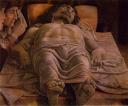Scholes spends a good deal of time discussing how Mantegna’s disturbing depiction of the dead Christ (“Very bitter…lots of nail holes”) figures in Hemingway’s fiction. Since I imagine this specific image is not part of our daily cultural vocabulary–and Scholes suggests it ought to be in order to push through from interpretation to criticism–I submit for you here the painting (click on the thumbnail for a larger version).
 Finished sometime around 1490, on the cusp of the Renaissance, “The Lamentation over the Dead Christ” now hangs at the Pinacoteca di Brera, Milan.
Finished sometime around 1490, on the cusp of the Renaissance, “The Lamentation over the Dead Christ” now hangs at the Pinacoteca di Brera, Milan.
So seeing Andrea Mantegna’s painting, does Scholes’ argument make more sense? Or do you, like myself, have some doubt about what Scholes’ particular critical move is in this chapter? How does familiarity with the image, or with the history of its genre (the dead Christ figure) help us adopt a critical stance toward Hemingway? If it does, how might this strategy (i.e. focusing upon a seemingly marginal cultural allusion, or a pattern of such allusions in a text) work with other texts, helping us help our students become more textually empowered?
I have doubts about all of Scholes’ ideas. I think that seeing anything connected with or being familiar with as much information about an author or the situation within which any text is written is imperative to understanding. Seeing the image provides context. Context provides understanding.
laurel chinn
I feel that the familiarity with the image helps to add to the power that Hemingway associated with that particular painting/artist. However, I disagree with what Scholes says about "We must do this [understand the cultural placement of Mantegna and how it has been modified by Hemingway’s private idiolect] for man reasons,… we need to position Hemingway as an Other, a distinct subjectivity, in order to criticize hime and define ourselves agains him"(50). Having read two of the three texts Scholes references, I never felt the need to find this information out. I’m sure that a question crossed my mind when reading, but that happens a lot and I don’t always follow up – apparently, I’ve been missing out. The other problem I have with this assertion is that it seem to me that it goes against the epigraph by Eco, "The reader finds his freedom …in choosing which codes to apply" (39). By telling me I must know this in order to understand Hemingway’s work Scholes is telling me that I have no freedom to choose which code I apply with which I completely disagree.